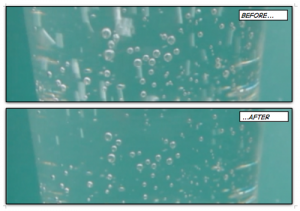More playing with a vacuum pump.
In this post, we talked about how decreasing the pressure on water can make dissolved gases come out of solution. But what happens if you suddenly increase the pressure again?
This is the same movie as in the previous post, just to remind you of what we did: We decreased the pressure and then let it increase again quickly (you hear the ssssssssssss when the air is streaming back into the bottle).
So to show it in one picture, what happens is basically this:

Bubbles under low pressure (top) and high pressure (bottom). Screen shots from the movie above.
The lower the pressure, the larger the bubbles. When you let the air back into the bottle, the bubbles collapse (or shrink, if you want to be less dramatic).
That reminds me that I really need to film a movie similar to the one below where one can clearly see how bubble size increases the closer the bubbles come to the surface.
Isn’t it awesome to realize that the more you film and write and think about adventures in oceanography and teaching, the more ideas you have of what you want to do next? :-)
I need help with this.
Do the bubbles get larger due to an increase in the volume gas itself, or because the gas is being released so much more that the gas is collecting for each bubble? What happens to a single molecule of oxygen (O2) under pressure. Assuming it is not dissolved in the water. Would this also increase in volume.
Im working a concept and need to understand what’s happening.
Hi Andrew,
I don’t think single molecules change their size under pressure (or at least not substantially with the pressure differences discussed here), but the effect you see is that gases change their volume depending on pressure. The lower the pressure, the larger the volume, hence the larger the bubbles.
Hope this helps!